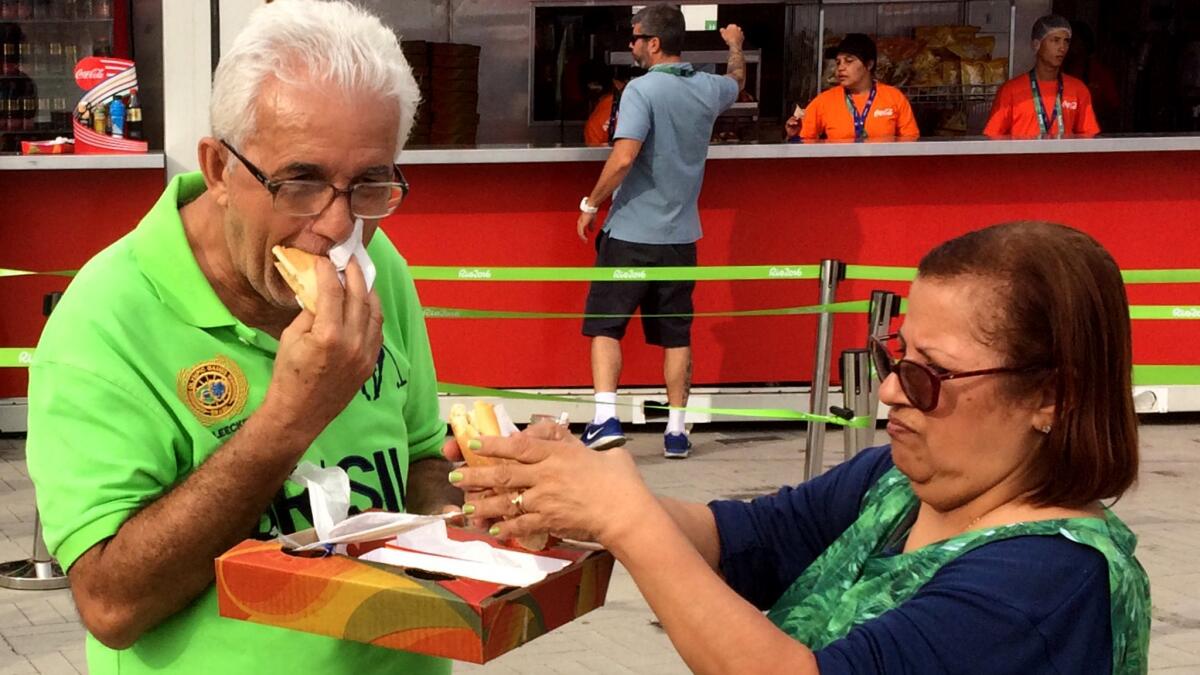Unhealthy food choices at Rio venues leaving a bad taste in mouths of some fans

- Share via
Reporting from Rio de Janeiro — In the U.S., the hot dogs always taste better at the ballpark. So by that logic, in Brazil shouldn’t the acai taste better at the Olympics?
That’s a trick question, of course. Acai, a yogurt-like dish of frozen, mashed palm fruit topped by granola that Brazilians are crazy about, tastes great everywhere. But apart from that, a tour of 13 venues in the Olympic Park and the nearby Riocentro cluster of arenas showed the Rio Games to be a veritable gastronomic wasteland.
Make that gastronomic waistland. Because the stuff they’re offering the fans here will make you fat: hot dogs, cheeseburgers, pizza and potato chips are the four food groups of these Olympics.
“It’s not very sports-minded,” Dutch fan Sjoerd Verlaan said.
Apparently Verlaan has never been to an Arizona Diamondbacks game, where the menu includes an 18-inch corn dog inside a chocolate glazed doughnut topped with caramel. But if he means the food isn’t healthy, he’s right.
Swimmer Michael Phelps is famous for his 12,000-calorie-a-day diet, but if he ate some of the empty-calorie stuff they serve inside the arena where he won the last of his 23 gold medals, he would have sunk like a rock.
“Cheeseburger, coca-colas, popcorn,” Verlaan complained Tuesday after finishing an ice cream and a beer, a combination he deemed to be less harmful.
And don’t even think about packing your own lunch. Verlaan’s friend, Anja Bos, tried to carry an apple into the Olympic Park and had it confiscated as contraband.
Francila Calica, manager of the media center for the arenas that staged judo, wrestling, fencing and taekwondo, said food bought at the more than three dozen snack stands inside the Olympic Park can be taken into any of the sports venues. But food and drinks bought outside the park, including apples, is collected by guards at the entrance.
The Olympic Park, which sprawls over 250 acres on the site of Rio’s former Grand Prix racetrack, includes 10 venues laid out around two massive, open public squares. It’s reminiscent of Disneyland, with people in shorts and sunglasses, some pushing strollers, all rushing in different directions.
They all have to eat, though, so the public squares are lined by food stands that once sold as many as 20 food items, ranging from a Brazilian pie to a sausage sandwich, with several other unfamiliar items in between. So for those trying to decide between a biscoito polvilho (cassava biscuit) and salgados (unnamed snacks) it was no doubt comforting to spot the familiar McDonald’s golden arches rising magically in the middle of the square like a lake in the middle of a desert.
Turns out it was a mirage. This McDonald’s sells only ice cream.
But at least they still have some. With five days to go in Games, nearly a third of the items listed at the concession stands are no longer available.
Although the prices are cheap — a double cheeseburger, selling for $5.32, is the most expensive item; snacks sell for less than $2 — ordering can be tricky. First you have to go to the cashier and stand in a long line to place your order with someone who knows nothing about what’s actually in the item you’re ordering. Then you take your receipt and go stand into another long line (Brazilians love lines) to pick up the food.
Lori Zanini, a registered dietitian-nutritionist from Manhattan Beach, found nothing on the Olympic menu that interested her.
“The menu could definitely use more protein and vegetables,” she said. (There are no salads or fruit either.)
Each of the arenas has its own concession stands, but the offerings there are pretty much the same as they are outside: cheeseburgers, hot dogs, potato chips.
Marina Davi and her sister Michelle, both from Rio, said the menu is typical of what you’d find at a sporting event in Brazil.
“It’s a problem,” Marina said. “It’s fast food.”
There were some exceptions but they were hard to find. Outside one exit of the team handball arena were two food trucks, one selling bananas with Nutella and a Brazilian dessert called tapioca doce. And in the media lounge at the gymnastics arena, three kinds of prepackaged salads sat unclaimed in a refrigerated display case.
About a mile away at Riocentro, a massive expo center hosting badminton, boxing, weightlifting and table tennis, only two of the four pavilions were large enough to have concession stands inside. But huge snack bars lined both sides of Riocentro’s center square.
One offered four flavors of “fruit” popsicles — except two of the flavors were chocolate, not exactly a fruit. (Nor, technically, is a coconut, a third flavor. But we’ll let that one slide.)
Riocentro’s menu also had something called “salty snacks,” which proved to be a catch-all term of Doritos and potato chips. Clearly if the Olympic rings were built from the menu at the Rio Games, two would be a pizza and a cheeseburger.
“I would give them a bronze medal,” Zanini, the nutritionist, said of the Rio Olympics snack-bar standing. “While they have a few healthy options, there aren’t many.”
Twitter: @kbaxter11
More to Read
Go beyond the scoreboard
Get the latest on L.A.'s teams in the daily Sports Report newsletter.
You may occasionally receive promotional content from the Los Angeles Times.





